Types and varieties of decorative climbing honeysuckle
Honeysuckle is edible and decorative. Edible used in cooking or eaten fresh, ornamental plants are grown to decorate gardens and summer cottages. Ornamental plants are planted around the perimeter of the site or in groups in the corners. Beautiful trees hide unsightly buildings, improve areas, or simply refresh the garden with their appearance. In the article we will look at which varieties of decorative honeysuckle to pay attention to and what recommendations to follow when growing them.
Description of decorative honeysuckle

Decorative honeysuckle is one of the most favorite plants of amateur gardeners and landscape designers. Original trees are valued for their ease of care, frost resistance and strong immunity. Decorative honeysuckle blooms from late May to mid-July, depending on the variety. And already closer to September, the trees are strewn with small inedible berries. The shoots of the tree reach 6 m, the leaves are oval, colored green with a purple tint. The size, color and shape of flowers depend on the variety.
Attention! Decorative honeysuckle belongs to the genus of erect, climbing or creeping perennial shrubs of the Honeysuckle family.
Types and varieties
For planting in the garden summer residents choose curly, bush, Chinese honeysuckle. Honeysuckle and Brown's honeysuckle are also popular.
Curly

This variety of honeysuckle blooms in late May or early June and looks like a grape vine. Grow it in central Russia, northern and southern regions - the plant quickly adapts to any climatic conditions. The leaves are ovate-oval, the outer side is dark green, the inner side is gray. The fruits are dark red, the flowers are pink-violet or white, with long petals.
Maaka
The Maaka variety is distinguished by large snow-white flowers and spherical bright red berries. The height of the bush is 4-5 m, the crown is spreading, the leaves are large and pointed. Flowers with weak pubescence, paired. The fruits ripen in the second half of August and are not suitable for food.
Maak's climbing honeysuckle ripens quickly, the shoots are strong and fruit-bearing. Shade-tolerant, but for abundant fruiting It is recommended to grow it in sunny areas. The variety is drought-resistant and grows even on rocky soil. Improve flowering due to regular pruning and fertilizing.
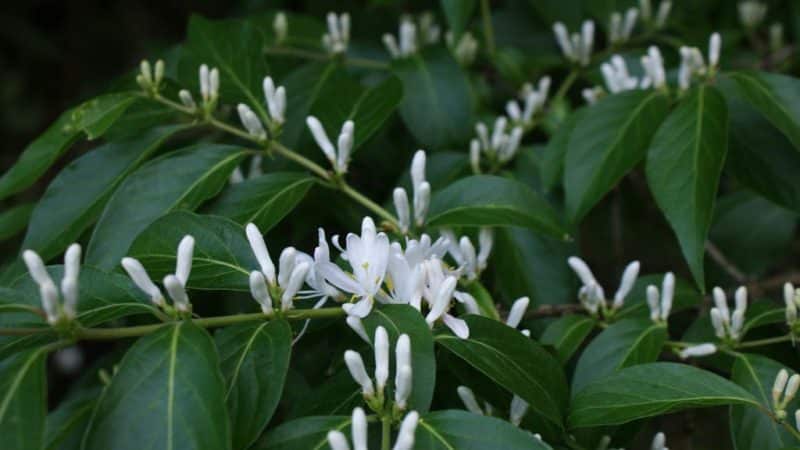
Belgica Select
Height - 4-6 m, leaves are rough and hard, green-blue color. Tubular-shaped flowers, yellow-red, original. Some varieties of Belgica Select flowers have a pink-violet hue. The berries are red and small. The variety blooms mainly in May and is unpretentious in terms of care and growing temperature. Even a few Belgica Select bushes will transform and improve the garden.
Chick Chock
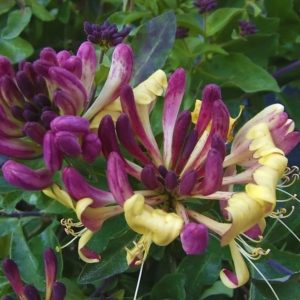
Honeysuckle is low-growing, up to 80 cm high. The bushes are compact, suitable for landscaping small garden plots. Chick Chok buds are purple-pink, at the moment of opening they acquire a rich pink-white hue, and over time they become orange-yellow. Flowering lasts from June to July. It is recommended to grow the climbing honeysuckle Chik Chok in regions with a temperate climate. Honeysuckle tolerates frosts down to -23°C.
Graham Thomas
A profusely flowering variety of climbing honeysuckle with a pleasant aroma. The white flowers turn yellow over time and are arranged in pairs or groups. Flowering begins in May and ends in September. The leaves are large and dense, which adds decorativeness to the plant. The height of the bush is 3-4 m, the annual growth reaches 2 m. Graham Thomas prefers wet and fertile soils. Used to decorate gazebos, arches, houses. Decorative red and orange honeysuckle fruits appear in June.
Honeysuckle
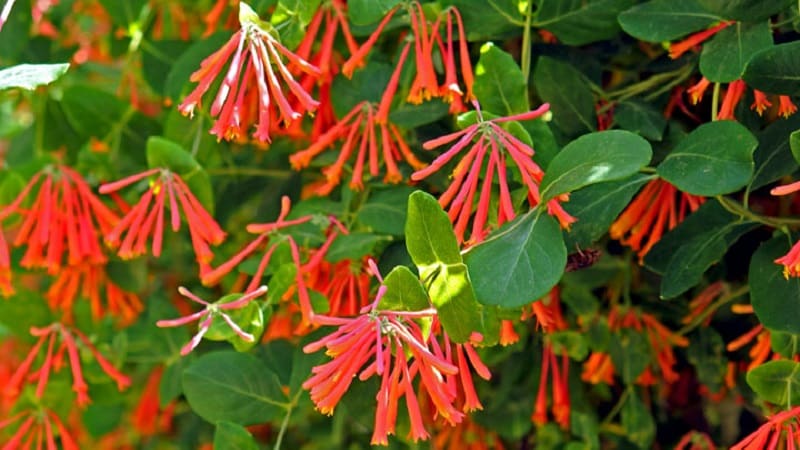
The most famous and popular decorative honeysuckle, honeysuckle prefers well-moistened and sunny areas; it grows poorly in the shade. Flowers appear in May - large and snow-white with a pleasant aroma. Sometimes, depending on the subspecies, honeysuckle blooms with yellow curved flowers. Decorative fruits appear in August and are orange or red. They are inedible. The climbing honeysuckle honeysuckle is winter-hardy, so it is suitable for planting in the northern regions of the country.
Harlequin
Harlequin blooms from June to September. The length of an adult plant is 3.5 m, width is 1.8 m. The leaves are green with a white or yellow-cream border. The outer side of the flowers is pink, the inner side is yellow. The aroma is pleasant, floral and fruity.
Harlequin is picky about the planting site, so the plant is grown mainly in the southern regions of the country. Honeysuckle is covered for winter and fed in spring and summer. The plant is pruned as necessary. Harlequin is recommended for vertical gardening and decorating gazebos.
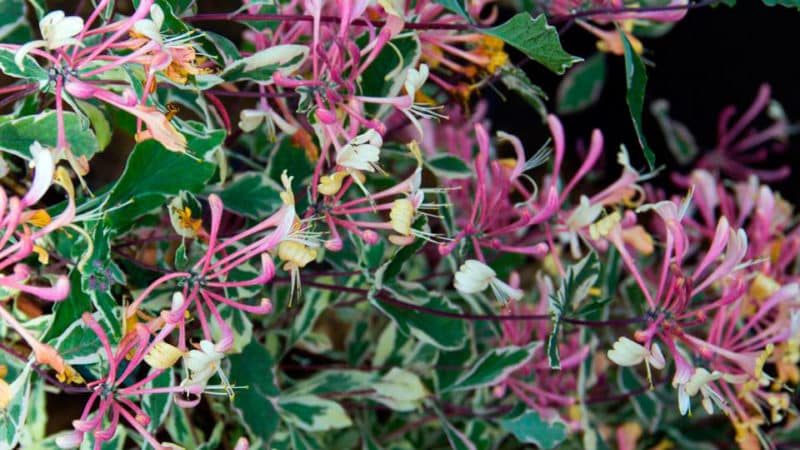
Bush
Bush honeysuckle reaches 6 m in height, the leaves are green with bluish, ovate. The length of the flowers is 5 cm, the color is yellow-red. The aroma is pleasant, floral.In the southern growing regions, flowers bloom already at the end of April, in the middle zone - at the beginning of May. Yellow inedible fruits appear in late July or mid-August. Bush honeysuckle is used to decorate arbors, hedges, arches, and garden houses. Flexible and thin shoots beautifully wrap around buildings.
Golden
The height of the bush is about 2 m, the crown is dense and spreading. The leaves are dark green, thick, reaching a length of 12 cm. The flowers are golden yellow with a pleasant honey aroma. The fruits are red, spherical. Golden blooms for about 2 weeks, flowering occurs in May or June. Honeysuckle bears fruit annually, starting from 4-5 years of age. Golden is undemanding to the soil and is frost-resistant. Shrubs are planted in groups or rows.
Attention! Sometimes gardeners worry that honeysuckle does not bear fruit the next year after planting. It is important to remember that fruiting occurs only in 4-5 years.
Chinese
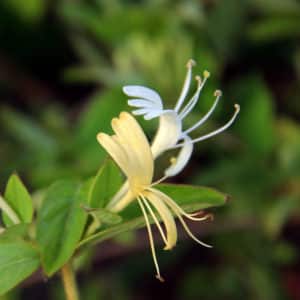
Chinese honeysuckle is an evergreen shrub. Height - no more than 1 m, some specimens do not reach 0.5 m. The crown is flat, up to 2 m in diameter. The shoots are rigid, spread along the ground, and quickly adapt to soil of different compositions. The leaves are glossy, small, dark green, with pubescent veins. In September, purple or red inedible fruits appear on the tree. Chinese honeysuckle can withstand temperatures down to -25°C, so it feels good in central Russia. In the north, plants are covered for the winter to protect them from frost and wind. Resistance to diseases and pests is average.
Shapochnaya
Cap honeysuckle is a popular Chinese variety. The bushes are low - up to 30 cm. The crown is flat, about 1.5 m wide. The leaves are small and oblong.The flowers are white, tubular, and purple berries appear in September. The cap plant does not require special care, so growing it is not a hassle.
Brown
A beautiful shrub with climbing shoots has received recognition from gardeners all over the world. The plant is a hybrid, distinguished by elliptical leaves and red-orange fuchsia-shaped flowers. Brown's honeysuckle blooms from July to October; after the flowers fall, yellow or red poisonous berries appear on the bush. For successful flowering, the plant needs the sun, thanks to which the shoots will always strive upward. The shrub is used for vertical gardening, decorating hedges, or planted individually.

Brown Blanche Sandman
The evergreen vine reaches a length of 3.5 m, the annual growth of shoots is 1 m. The leaves are rich green, medium in size, glossy. The flowers are large, tubular, purple-burgundy with a yellow center. Fruiting continues from July to October. The aroma is bright and pleasant and lasts throughout the entire flowering period. Brown Blanche Sandman is suitable for horizontal and vertical gardening. For the winter, honeysuckle is covered, and with the arrival of spring, fertilizers are applied. The variety branches well if the ovaries are removed after flowering.
Features of planting and caring for decorative honeysuckle
For planting, choose an annual cutting with a branched root system. It is inspected for external damage - stains, rot, cracks. Experienced gardeners recommend purchasing planting material from specialized nurseries.
Landing rules

Honeysuckle is planted in early spring or autumn. Prepare a planting hole with a diameter of 50 cm and a depth of 60 cm, fertilize it with organic matter and prepare a drainage layer of broken brick or crushed stone. The distance between the pits must be at least 2.5 m. Otherwise, the crowns of the bushes will obscure each other.
For planting, choose a cloudy and windless day. The hole is watered generously with warm water, the roots are carefully straightened and placed in the hole. Sprinkle the seedling with soil so that only the root collar of the plant remains on the surface.
Water the soil again, compact the soil with a spatula or hands and sprinkle with mulch - sawdust, hay, grass, leaves or pine needles. Mulching prevents moisture evaporation, improves soil quality and stimulates metabolic processes.
How to care
Caring for decorative honeysuckle involves timely watering and fertilizing, as well as annual pruning. If all recommendations are followed, honeysuckle blooms profusely, has dense foliage and a sweet floral aroma.
Watering
Honeysuckle does not tolerate waterlogging, but it also suffers from lack of water. Water the bush once every 2-3 weeks, 10-15 liters of water are needed per plant. If the weather is hot and dry, the amount of moisture is increased. They use settled water heated in the sun; cold watering provokes the development of fungal and bacterial diseases. Moisturize honeysuckle in the morning or evening to avoid sunburn.
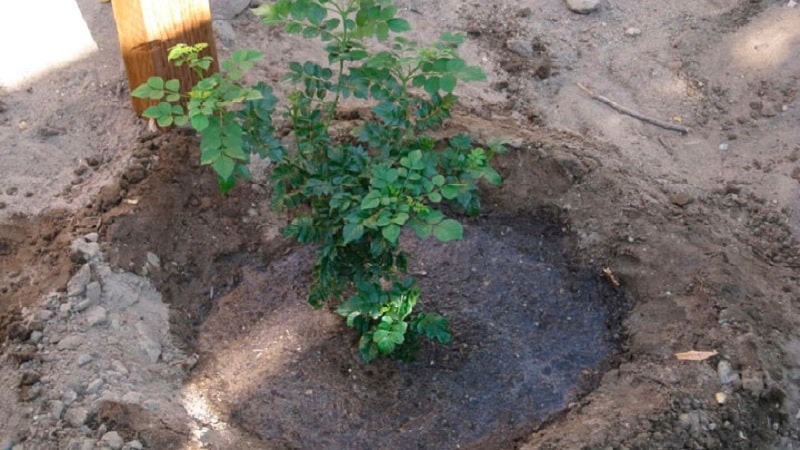
Fertilizer application
Gardeners do not feed honeysuckle for 2-2.5 years. The plant feeds on fertilizers that were added to the hole when planting. In the third year, superphosphate is added to each bush. Fertilizing strengthens the root system and stimulates flowering. Honeysuckle also responds well to nitrogen fertilizers; ammonium sulfate or ammophos is added to the bush.Young plants respond well to spraying with Zircon. Bush processing affects the plant's immunity. In late autumn, plantings are fertilized with compost or humus.
Attention! Foliar feeding protects honeysuckle from diseases and pests. For treatment, use a solution of copper sulfate or Bordeaux mixture. The procedure is carried out once every 2-3 weeks during flowering.
Trimming
Pruning begins at the 4th year. Sharp pruners are used to trim twisted and diseased shoots that prevent the growth of new branches. Once every 5-6 years, anti-aging pruning is carried out - old shoots are removed. If you do not carry out the procedure, in a few years the crown will turn into a tangled lump of branches, and the honeysuckle will lose its decorative and well-groomed appearance. Pruning also prevents insects and rodents.
Ornamental honeysuckle berries

Berries appear on the bushes from June to September, depending on the variety. They are colored yellow, red, black, purple, pink or black. Most fruits are spherical and large. They are not suitable for food; they perform only decorative functions.
Conclusion
Decorative honeysuckle is a decoration for any area. In order for the plant to grow healthy and beautiful, gardeners prepare a place for planting in open ground in advance, fertilize the hole and prepare a drainage layer.
Growing honeysuckle does not require special skills; care consists of watering, pruning, and fertilizing. Among the varieties, gardeners distinguish decorative climbing honeysuckle, Harlequin and Maaku. They are distinguished by beautiful and fragrant flowers and will decorate any garden.